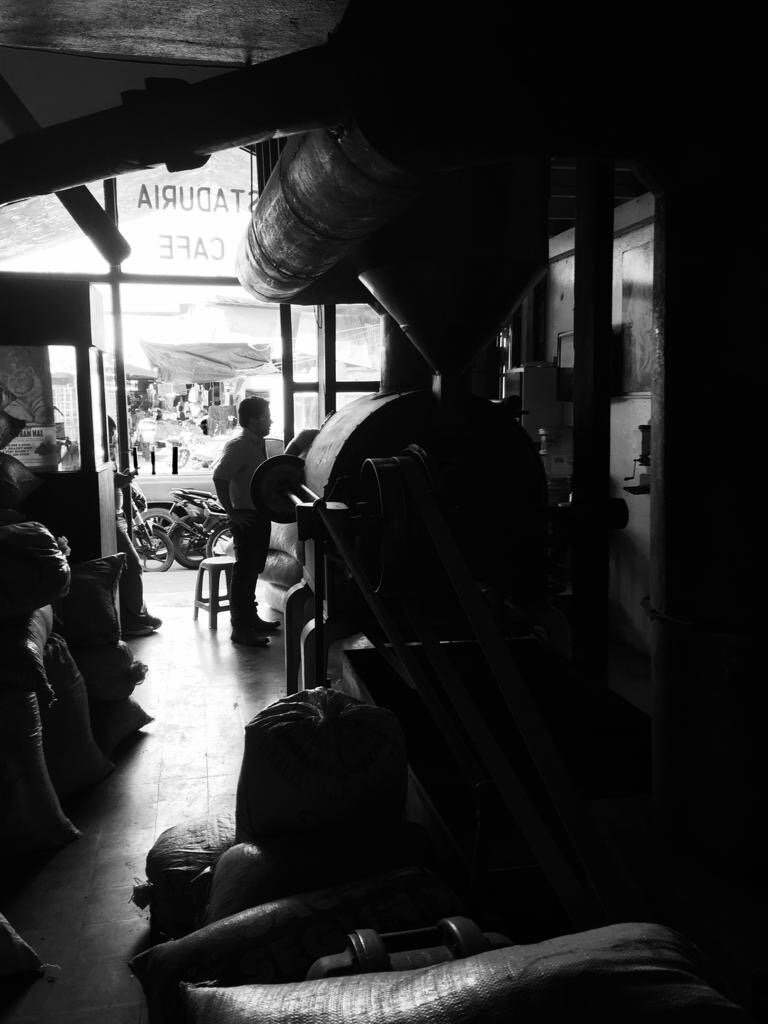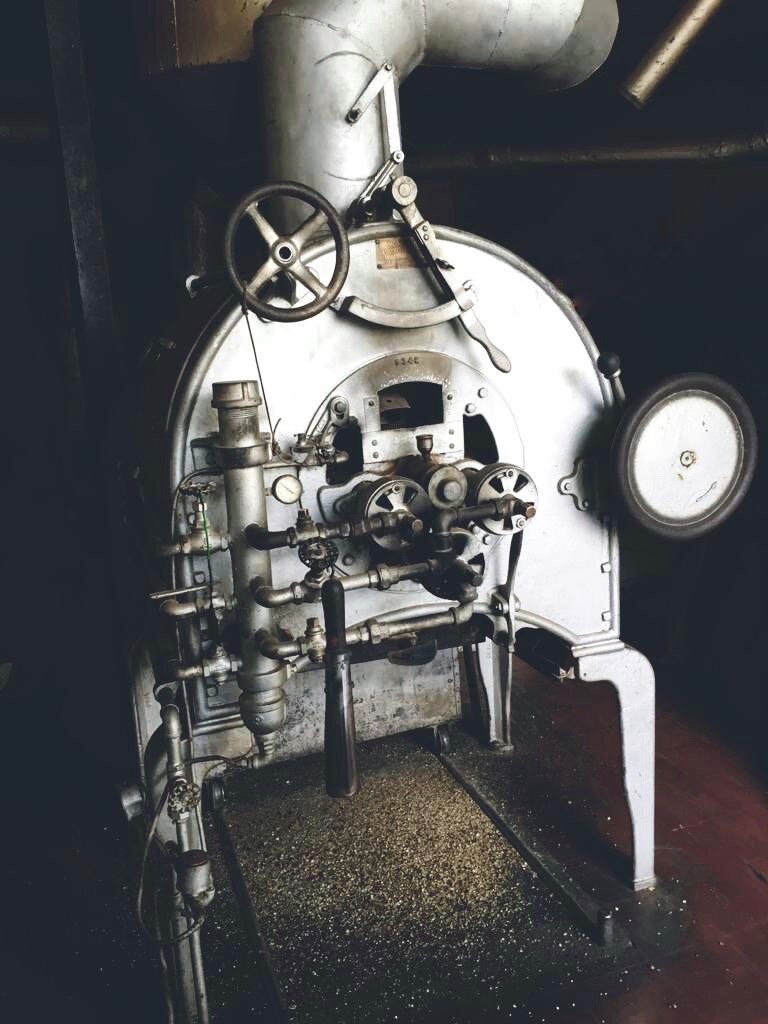What does Specialty Coffee mean to me?
I was in the Specialty Coffee industry before I even knew what it was.
The Roastery at San Marcos El Tigre. La Terminal. Ciudad de Guatemala.
My name is Josué Morales and I have been in the coffee industry since 2003. I started in the Specialty Coffee segment of the industry. The funny part is, back then, I didn’t even know what Specialty Coffee was.
Back in the day, I was just a nineteen year old kid. I was in my second year of university and I had a job at the City Hall of Guatemala City, which was a dream job for someone my age.
I’ve always had a knack for trading. Buying and selling stuff has always made me happy in a way that no other profession could ever do. It was through that window of thrill that coffee came into my life.
Every day, during my lunch break, I would take a bus from the City Hall to the God-forsaken market called “La Terminal,” which is the place where most of the city’s businesses have sourced their produce and supplies for over a century.
“La Terminal” is a place like no other. With its crowded streets so full of people that cars can barely move. I walked the dirty streets under the midday sun blazing on top of my head, full of noise, smoke, and the smell of rotting fruits and vegetables filling up the air. On rainy days the heat and the moisture made the smells so pungent that it was hard to breathe.
The crowd. The smoke. The noise. The filth. It was definitely the worst place to be for the senses. But it was also the pulsating heart of the city. It was exploding with life. A majestic dance of vitality. I fell in love with it.
I would get off on Segunda Calle and walk about twelve blocks into the far end of the market to a place called “Comercial El Éxito.” At the end of its narrow street I would find a roastery called “San Marcos El Tigre.” This is the roastery that I had hired to roast and package the coffee that I was selling.
Upon entering the shop, the crackling sounds of their ancient roasting machine would greet me by spitting out the smoke that lingered in the air once coffee finished roasting. It was here, at the foot of this machine, that I discovered that working in coffee made me happy.
The roasting machine at San Marcos El Tigre.
I acquired the fondness for the sensation of holding the shiny roasted beans in my hands. It was also here, in this roastery, that I met the first coffee producers that helped me get started with my own business.
These coffee producers were here purely out of tradition. Their parents had brought their coffee to be roasted here and their parents before them. They would come at the end of harvest to roast the coffee they would drink at home during the rest of the year. We probably ended up coming here because of the same reasons, upon calling all the roasteries listed on the phone book this one offered the lowest price.
I made the best imaginable use of this tradition. While I was there, instead of minding my own business like everyone else did, I got the producers permission to pull out small samples of their coffees. I brewed and tasted it with them as we waited for their coffee to be packaged.
I can clearly remember when Ovidio, the owner of “San Marcos El Tigre”, allowed me to set up the most precarious tasting station on a tiny corner of his desk.
It was here, in this negligible tasting station, improvised on the corner of a messy battered desk, where I started discovering taste.
The taste of coffee would differ from one region to another; from one farm to another. Even within one farm it would be different from one batch to another, and the very same coffee would completely vary its taste if it was roasted at a different temperature.
Having grown up in a producing country, most of what I had tasted before was second and third grades of pre ground and pre blended coffees. The coffees that I was tasting on my little corner of that desk were something completely new to me. They were exciting.
Fast forward one year and I was opening my own roasting business. I had landed a couple of fairly good accounts and I had somewhat of an idea of how much I needed to be making to keep my startup afloat.
My financial situation wasn’t strong. I was only able to buy from producers who would give me credit.
Doing all the manual labor triggered my imagination. It allowed my obsession with numbers and my obsession with measuring to be able to register everything.
I personally received each and every bag. I personally roasted each and every batch. I personally packaged each and every pound. I personally delivered each and every order.
The unavoidable result was that I got to know each and every coffee very, very well, to the point that I was able to detect even the slightest change in taste and appearance.
There were variations from one batch to another, from one delivery to another, and even coffee that was delivered on the same truck sometimes looked, smelled, and roasted differently. These variations were something that I never saw coming. They keep messing with my mind till this day.
I tried to make sense of these variations with every resource that I had at hand but nothing really worked. Nothing that I tried really meant a thing. And believe me, everything that you can imagine, I tried. Multiple tests batch after batch, day after day. But nothing that I did was helping me develop the right metrics to understand the changes each coffee presented.
I got to the point where I was disappointed with myself because I couldn’t explain these variations. I was hitting a dead end. In my sleepless nights I figured it out, it became evident to me that there was one thing and only one thing that I could do to figure out what was going on.
I had to go out into the fields.
And so I did. I went out on a research expedition to find out where the variations in taste came from. Reconnecting with my friends, the producers that had helped me this far was the starting point of understanding. The only things I took with me was a notebook, a sleeping bag and my obsession with measuring, registering, and documenting everything.
But how do you recognize the variables that affect taste out in the fields? How can you tell from looking at the plants? How can you tell from watching how the people handle the coffee in each farm?
For the purpose of my initial research, it was very lucky for me that the producers I worked with weren’t many at the time. I visited each and every farm, from the high mountains of Huehuetenango, to the lowlands near the Pacific Coast, and everything in between, including the very special regions of Antigua, Palencia and Atitlán.
I walked each and every path, and shook the rough hands of each and every coffee picker that touched the coffee beans that I was buying.
Nineteen year old Josué Morales. Finca Montes Eliseos. Guatemala.
Yes, I know, probably most of this work was not necessary, and it had been done before by many others. But my obsessive mind made me go through each and every detail of the whole process, and it made me document it.
From the individual trees and their health, to the harvesting and the quality of the selection –WHEN was the specific day that each bean had to be harvested, or not– to the handling and the shipment of each and every single batch that I bought, so that in the end, I could trace the taste that made each coffee unique back to its handling, back to their harvesting, and even back to their development on the coffee trees.
Before I knew it, I had created a system that could trace the occurrence of any specific taste back to the whole process that was behind it.
This personal and exploratory research made me aware of how each step of the process of producing coffee could affect its taste. I got to the point where I developed a taste of the farms. Just by looking at how the people were taking care of the trees and how the people were harvesting and handling the coffee I could tell what the result would be in the cup.
The taste of the cup, I discovered, always came down to the actions that people do along the process. And my obsessive-compulsive mind made me register, document, synthesize, and analyze all these actions.
Based on that, year after year, I started guiding producers away from the practices that would end up in tastes that were less desired by my customers and closer to the practices that would end up in the characteristics that were more greatly desired and rewarded.
I was orchestrating a very complex process involving many different people in many different circumstances in such a way that they would end up delivering coffee of such quality that I could roast them in extraordinary ways.
It was years later that I learned that the things that I was doing had a name. The process of documenting where each coffee bean comes from and how it has been harvested and handled is called Traceability. And the pursuit of the best quality in the cup, to which I’ve dedicated my entire adult life, is referred to as Specialty Coffee.
Learning these words has not changed the meaning I assign to my work. One thing is how Specialty Coffee is defined. A much different thing is to realize what it means to me.
I personally know the owners of each and every one of the farms I buy coffee from. I have been in those farms. I have eaten at their tables. I have slept in their houses. I have walked those farms end to end with the producers. I have memorized every corridor formed by their trees. I have learned their stories.
We have a personal bond such that I can make any specific request on the standards that any specific batch must meet; and they can ask me for help or advice immediately whenever things are not going as planned or an unexpected event has happened.
One of the best byproducts of my research has been the very strong personal relationship with each and every one of the coffee producers I work with. We have spent so much time together that they know for sure that they don’t need to hide anything from me and that I reciprocate by understanding the importance and the value each bag of coffee represents to them.
This amazing result of friendship and trust, focused on excellence, is what Traceability or Specialty Coffee mean to me. Two concepts that are two sides of the same coin.
Specialty Coffee is knowing who produced my coffee and where it comes from; and through this combination understanding that coffee has the ability to reflect the characteristics of the place it comes from and the personality of the people who produced it.
It occurs that in my case practice came first and the vocabulary to define it came later.


